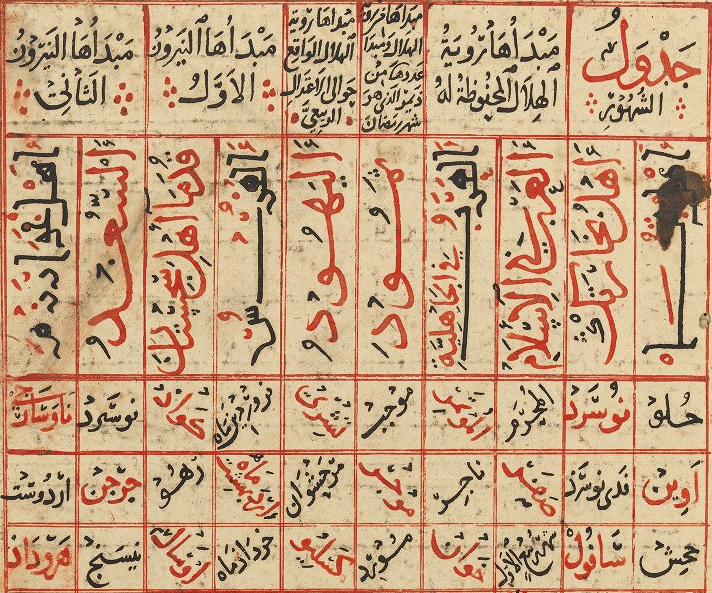The Edinburgh manuscript (Or. ms. 161) of al-Biruni’s Chronology (الاثار الباقية عن القرون الخالية), is not only one of the earliest witnesses of the work, with a date of 1307 CE, but is also probably the most beautiful, bearing numerous illustrations and tables rendered in fine calligraphy. It is now digitized in its entirety and available to view online through the University of Edinburgh’s library. For some lectures concerning the most recent work on the Chronology, particularly by François de Blois, see this page, part of a major UCL project on ancient and medieval calendars. For more on the Edinburgh manuscript itself and the context of its production, see “The Edinburgh Biruni Manuscript: A Mirror of Its Time?” by Robert Hillenbrand.
Al-Biruni, of course, cites a number of terms in Chorasmian, his native tongue, as well as in Sogdian, another Middle Iranian language he was very familiar with. Due to the high quality of the Edinburgh manuscript, the Chorasmian and Sogdian terms are quite clear. Here, I thought it worth showing two folios in particular.
⁓1⁓
Folio 37r presents a table giving the names of the months according to a variety of peoples both ancient, such as the “Arabs in the Jāhiliyya” and the Thamudians (ثمود), and contemporary, such as the Sogdians (السغد) and the Chorasmians (اهل خوارزم).

The month names for Chorasmian and Sogdian are as follows.

One can see in a few places how the letters are mispointed, suggesting that the scribe, who was nevertheless very astute, was not familiar with the words. I’ve noted with an asterisk the forms that are slightly incorrect in this manuscript based on what is known from other sources. The only major discrepancy is that the first Chorasmian month is given as n’ws’rc, a form close to the Sogdian nwsrd, whereas in other Biruni mss. and Chorasmian texts the name of this month is (β)rwrcn (cf. Avestan fravaṣ̌inąm). The Chorasmian is otherwise quite a bit closer to the Avestan than the Sogdian, as is well known.
It can also be noticed how the sounds [č] and [ts] are inconsistently represented. The Chorasmian c [ts] (on which see this recent article) is given at times with ج and at others with چ, while Sogdian č [č] is often given just with ج.
⁓2⁓
Folio 82v displays a nice table giving the names of the seven planets (الكواكب السبعة) in “Chorasmian” (الخوارزمية)—in addition to Arabic, Greek (الرومية), Syriac (السريانية), Hebrew, and Sanskrit (lit. “Indian” الهندية); no Sogdian this time—as follows (bottom row, right to left):

Saturn (Ar. زحل) — blank (! but note that Sogdian has kyw’n)
Jupiter (المشتري) — rymžd (ريمژد)
Mars (المريخ) — ’rṯġn* (اريغن)
Sun (الشمس) — ’xyr (اخير)
Venus (الزُهَرة) — n’hyc (ناهيچ)
Mercury (عطارد) — cyry (چيري)
Moon (القمر) — m’h (ماه)
While the Sogdian information from the Chronology only confirms, with very slight differences, what is also known from other Sogdian calendrical sources (especially the Mugh and Turfan documents), the Chorasmian forms given by al-Biruni greatly improve our poor understanding of the calendrical terms attested in the hardly-legible Middle Chorasmian documents in Aramaic script.
